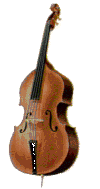Double Bass
 The double bass, also called bass VIOL or contrabass, is four-stringed, the largest instrument of the rondalla, shaped like the violin with two f sound holes, provides the fundamental tone, and reinforces the rhythm. Until 1910, the bass guitar was just slightly bigger than the ordinary guitar and was played in the same manner as the guitar, placed on the lap. Later, the bass guitar adapted a tailpiece and was henceforth played with the player standing up. With the tailpiece this instrument is adjustable to suit the player's height. In the interior of the bass, a small piece of round wood is fixed immediately behind the right foot of the bridge, to act as a support. It is called the "sound post." Under the bridge's left foot a strip of wood known as the "bass bar" is glued lengthways along the belly. It has different sizes: 1/2, 3/4, 7/8, or a full size. A 1/2 or 3/4 size double bass is usually used in the elementary grades, and 3/4, 7/8 or a full size double bass is for junior or senior high school students depending on the person's physical stature.
The double bass, also called bass VIOL or contrabass, is four-stringed, the largest instrument of the rondalla, shaped like the violin with two f sound holes, provides the fundamental tone, and reinforces the rhythm. Until 1910, the bass guitar was just slightly bigger than the ordinary guitar and was played in the same manner as the guitar, placed on the lap. Later, the bass guitar adapted a tailpiece and was henceforth played with the player standing up. With the tailpiece this instrument is adjustable to suit the player's height. In the interior of the bass, a small piece of round wood is fixed immediately behind the right foot of the bridge, to act as a support. It is called the "sound post." Under the bridge's left foot a strip of wood known as the "bass bar" is glued lengthways along the belly. It has different sizes: 1/2, 3/4, 7/8, or a full size. A 1/2 or 3/4 size double bass is usually used in the elementary grades, and 3/4, 7/8 or a full size double bass is for junior or senior high school students depending on the person's physical stature.
TUNING
- The bass guitar (bajo de uņas) has 4 strings and is tuned in fourths.
- First String
- G (sol), the first below G below the middle C of the piano
- Second String
- Third String
- Fourth String
DIMENSIONS
Scale length: in. (distance from the nut to the bridge)
Tuning head length: in.
Tuning head width: in.
Fingerboard length: in.
Fingerboard width
at Nut: in.
at last Fret: in.
Frets:
Total:
Clear of body joint: (usually marked with double dots)
|
Total length : in.
Body length: in.
Body width: in.
Sound hole - f: in.
Rim depth: in.
Bridge width: in.
Bridge height: in.
Bracing:
|
No. of Strings: 4
String gauges:
1st course(1 string) G
unwound steel: .076 in.
2nd course(1 string) D
unwound steel: .094 in.
3rd course(1 string) A
copper-wound steel: .104 in.
4th course(1 string) E
copper-wound steel: .140 in.
|
</BODY>
</HTML>
 The double bass, also called bass VIOL or contrabass, is four-stringed, the largest instrument of the rondalla, shaped like the violin with two f sound holes, provides the fundamental tone, and reinforces the rhythm. Until 1910, the bass guitar was just slightly bigger than the ordinary guitar and was played in the same manner as the guitar, placed on the lap. Later, the bass guitar adapted a tailpiece and was henceforth played with the player standing up. With the tailpiece this instrument is adjustable to suit the player's height. In the interior of the bass, a small piece of round wood is fixed immediately behind the right foot of the bridge, to act as a support. It is called the "sound post." Under the bridge's left foot a strip of wood known as the "bass bar" is glued lengthways along the belly. It has different sizes: 1/2, 3/4, 7/8, or a full size. A 1/2 or 3/4 size double bass is usually used in the elementary grades, and 3/4, 7/8 or a full size double bass is for junior or senior high school students depending on the person's physical stature.
The double bass, also called bass VIOL or contrabass, is four-stringed, the largest instrument of the rondalla, shaped like the violin with two f sound holes, provides the fundamental tone, and reinforces the rhythm. Until 1910, the bass guitar was just slightly bigger than the ordinary guitar and was played in the same manner as the guitar, placed on the lap. Later, the bass guitar adapted a tailpiece and was henceforth played with the player standing up. With the tailpiece this instrument is adjustable to suit the player's height. In the interior of the bass, a small piece of round wood is fixed immediately behind the right foot of the bridge, to act as a support. It is called the "sound post." Under the bridge's left foot a strip of wood known as the "bass bar" is glued lengthways along the belly. It has different sizes: 1/2, 3/4, 7/8, or a full size. A 1/2 or 3/4 size double bass is usually used in the elementary grades, and 3/4, 7/8 or a full size double bass is for junior or senior high school students depending on the person's physical stature.